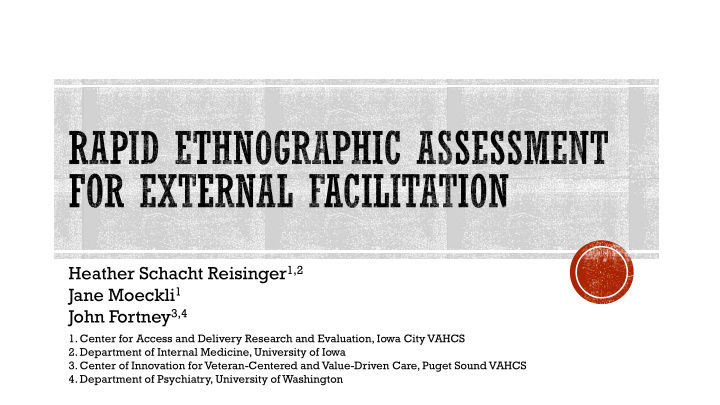



Heather Schacht Reisinger 1,2 Jane Moeckli 1 John Fortney 3,4 1. Center for Access and Delivery Research and Evaluation, Iowa City VAHCS 2. Department of Internal Medicine, University of Iowa 3. Center of Innovation for Veteran-Centered and Value-Driven Care, Puget Sound VAHCS 4. Department of Psychiatry, University of Washington
No disclosures The views expressed in this presentation do not necessarily represent the views of the U.S. Department of Veterans Affairs Acknowledgements: -Virtual Specialty Care QUERI -VA Office of Rural Health
▪ Defining and Framing Ethnography ▪ Telemedicine Outreach for PTSD (TOP) ▪ Rapid Ethnographic Assessment (REA) ▪ TOP and REA ▪ Lessons Learned
▪ Ethnography ▪ … as the study of the nature of knowledge, justification, and rationality of belief
▪ Ethnography ▪ … as the study of the nature of knowledge, justification, and rationality of belief ▪ Heather’s translation 1 : ▪ Ethnography is a methodology to understand how people know what they know, believe what they believe, and justify it to themselves and the world. 1 Heavily influence by a six+ year apprenticeship with Mike Agar, author of Professional Stranger and The Lively Science , among others.
▪ Three concepts from anthropology that I can never seem to leave behind: 1. Emic/Etic 2. Cultural Relativism/Ethnocentrism 3. Holism
▪ Rural Veterans with PTSD treated at community based outreach clinics (CBOCs) experience little to no improvement in their symptoms over time ▪ Trauma-focused evidence-based psychotherapy (EBP) is key to improving PTSD outcomes ▪ EBP is not being provided in CBOC settings
▪ TOP Randomized Control Trial (Fortney, PI) ▪ 11 CBOCs, 4 states ▪ Care Manager at the medical center ▪ Calls to Veterans diagnosed PSTD and are not being treated in a specialty mental health clinic (Casefinder) ▪ Motivational interviewing to encourage Veterans to do EBP ▪ Ongoing calls to support Veterans engaged in EBP ▪ Telepsychologist delivering EBP to Veterans via interactive televideo at their CBOC ▪ Telepsychiatrist providing medication management
▪ 54.9% of Veterans randomized to TOP initiated EBP compared to 12.1% of Veterans in usual care (OR=18.1; p<0.001) ▪ 27.1% of Veterans randomized to TOP completed ≥8 sessions of EBP compared to 5.3% of Veterans in usual care (OR=7.9%, p<0.001) ▪ Veterans in TOP had significantly larger reductions in PTSD symptom severity at 6 and 12 month follow-ups (p= 0.02 and p=0.04)
▪ Step-wedge design ▪ All sites implemented TOP based on standard implementation strategy (distribution of manual and monthly calls among site leads) ▪ If sites failed the benchmark (<20% Veterans on casefinder enrolled in EBP for PTSD), randomly assigned to receive enhanced implementation strategy or continue as usual ▪ Enhanced implementation strategy ▪ External facilitation informed by rapid ethnographic assessment (REA)
▪ “[REA] is defined as intensive, team -based qualitative inquiry using triangulation, iterative analysis and additional data collection to quickly develop a preliminary understanding of a situation from the insider’s perspective.” (Beebe, 2001:xv) ▪ Other names for the method: ▪ Rapid Rural Appraisal ▪ Rapid Assessment Process/Procedures/Protocol ▪ Rapid Qualitative Inquiry
▪ Anthropologists were hired in the 1960s and 1970s to work for international development agencies to answer this question: Why was this [agricultural/nutrition/healthcare] program successful in X country, but when we imported it into Y country we did not see the same results? ▪ In the beginning, it was anthropologists working among a particularly culture group (the expert) ▪ BUT then were moved to another country to “do the same thing”
Why was this [agricultural/nutrition/healthcare] program successful in X country, but when we imported it into Y country we did not see the same results? Why did this intervention work in X healthcare system, but not in Y?
“…rough approximations delivered at the right time are better than precise results delivered too late for decision makers to act on them…” --McNall et al, 2007:155
▪ Focused question, focused analysis ▪ Semi-structured interview guides and surveys ▪ Templated analysis ▪ Team-based (multi-disciplinary, preferably individuals working in the area) ▪ Go to the location/setting ▪ Methods traditionally associated with ethnography (direct observation, open-ended interviews and focus groups, surveys, organizational and archival documents, mapping sites) ▪ … and the epistemology remains the same: insider perspective, withhold judgement, and striving for comprehensive, complex understanding
▪ Three site visits ▪ Interviews with care managers, site project leads, telepsychologists, telepsychiatrists, other mental health providers, CBOC providers, leadership ▪ Visits to medical center and CBOCs ▪ Conducted by two ethnographers ▪ Create a clinical workflow map based on visits ▪ Shared workflow map and reported back to full external facilitation team (Project Lead, Veteran, AND the two ethnographers) ▪ Designed an external facilitation plan ▪ Shared workflow map with site stakeholders and suggested changes to workflow
▪ Clinical workflow mapping is a great ethnographic tool. ▪ Did you capture the insider perspective? ▪ Was it comprehensive and demonstrate the right level of complexity? Lesson #1: REA provides rich, insider perspective data that can be translated into a clinical workflow map and helps establish trust with local sites. ▪ GOAL: Veterans receive EBP for PTSD. CHALLENGE: I wanted to withhold judgement. Lesson #2: Anthropologists/ethnographers may not be good external facilitators.
Heather Schacht Reisinger heather.reisinger@va.gov heather-reisinger@uiowa.edu
Recommend
More recommend